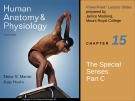
Sense of smell
-
Chapter 15 - The special senses (part c) provides knowledge of the chemical senses: taste and smell. This chapter focus describe the location, structure, and afferent pathways of taste and smell receptors, and explain how these receptors are activated.
 41p
41p  tangtuy07
tangtuy07
 02-04-2016
02-04-2016
 38
38
 2
2
 Download
Download
-
Approach to the Patient: Disorders of the Sense of Hearing The goal in the evaluation of a patient with auditory complaints is to determine (1) the nature of the hearing impairment (conductive vs. sensorineural vs. mixed), (2) the severity of the impairment (mild, moderate, severe, profound), (3) the anatomy of the impairment (external ear, middle ear, inner ear, or central auditory pathway), and (4) the etiology. The history should elicit characteristics of the hearing loss, including the duration of deafness, unilateral vs. bilateral involvement, nature of onset (sudden vs.
 5p
5p  ongxaemnumber1
ongxaemnumber1
 29-11-2010
29-11-2010
 83
83
 5
5
 Download
Download
-
Disorders of the Sense of Hearing Hearing loss can result from disorders of the auricle, external auditory canal, middle ear, inner ear, or central auditory pathways (Fig. 30-4). In general, lesions in the auricle, external auditory canal, or middle ear cause conductive hearing losses, whereas lesions in the inner ear or eighth nerve cause sensorineural hearing losses. Figure 30-4 An algorithm for the approach to hearing loss.
 5p
5p  ongxaemnumber1
ongxaemnumber1
 29-11-2010
29-11-2010
 78
78
 5
5
 Download
Download
-
Disorders of the Sense of Taste Disorders of the sense of taste are caused by conditions that interfere with the access of the tastant to the receptor cells in the taste bud (transport loss), injure receptor cells (sensory loss), or damage gustatory afferent nerves and central gustatory pathways (neural loss) (Table 30-2). Transport gustatory losses result from xerostomia due to many causes, including Sjögren's syndrome, radiation therapy, heavy-metal intoxication, and bacterial colonization of the taste pore.
 5p
5p  ongxaemnumber1
ongxaemnumber1
 29-11-2010
29-11-2010
 77
77
 7
7
 Download
Download
-
Approach to the Patient: Disorders of the Sense of Taste Patients who complain of loss of taste should be evaluated for both gustatory and olfactory function. Clinical assessment of taste is not as well developed or standardized as that of smell. The first step is to perform suprathreshold whole-mouth taste testing for quality, intensity, and pleasantness perception of four taste qualities: sweet, salty, sour, and bitter. Most commonly used reagents for taste testing are sucrose, citric acid or hydrochloric acid, caffeine or quinine (sulfate or hydrochloride), and sodium chloride.
 5p
5p  ongxaemnumber1
ongxaemnumber1
 29-11-2010
29-11-2010
 76
76
 5
5
 Download
Download
-
Definitions Disturbances of the sense of taste may be categorized as total ageusia, total absence of gustatory function or inability to detect the qualities of sweet, salt, bitter, or sour; partial ageusia, ability to detect some but not all of the qualitative gustatory sensations; specific ageusia, inability to detect the taste quality of certain substances; total hypogeusia, decreased sensitivity to all tastants; partial hypogeusia, decreased sensitivity to some tastants; and dysgeusia or phantogeusia, distortion in the perception of a tastant, i.e.
 6p
6p  ongxaemnumber1
ongxaemnumber1
 29-11-2010
29-11-2010
 75
75
 5
5
 Download
Download
-
Disorders of the Sense of Smell These are caused by conditions that interfere with the access of the odorant to the olfactory neuroepithelium (transport loss), injure the receptor region (sensory loss), or damage central olfactory pathways (neural loss). Currently no clinical tests exist to differentiate these different types of olfactory losses. Fortunately, the history of the disease provides important clues to the cause.
 5p
5p  ongxaemnumber1
ongxaemnumber1
 29-11-2010
29-11-2010
 84
84
 5
5
 Download
Download
-
Approach to the Patient: Disorders of the Sense of Smell Unilateral anosmia is rarely a complaint and is only recognized by testing of smell in each nasal cavity separately. Bilateral anosmia, on the other hand, brings patients to medical attention. Anosmic patients usually complain of a loss of the sense of taste even though their taste thresholds may be within normal limits. In actuality, they are complaining of a loss of flavor detection, which is mainly an olfactory function.
 5p
5p  ongxaemnumber1
ongxaemnumber1
 29-11-2010
29-11-2010
 85
85
 5
5
 Download
Download
-
Harrison's Internal Medicine Chapter 30. Disorders of Smell, Taste, and Hearing Smell The sense of smell determines the flavor and palatability of food and drink and serves, along with the trigeminal system, as a monitor of inhaled chemicals, including dangerous substances such as natural gas, smoke, and air pollutants. Olfactory dysfunction affects ~1% of people under age 60 and more than half of the population beyond this age. Definitions Smell is the perception of odor by the nose. Taste is the perception of salty, sweet, sour, or bitter by the tongue.
 6p
6p  ongxaemnumber1
ongxaemnumber1
 29-11-2010
29-11-2010
 91
91
 7
7
 Download
Download
CHỦ ĐỀ BẠN MUỐN TÌM





















